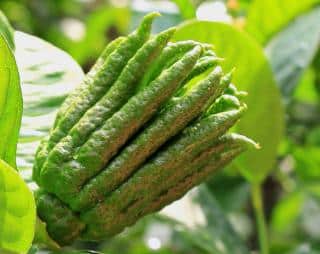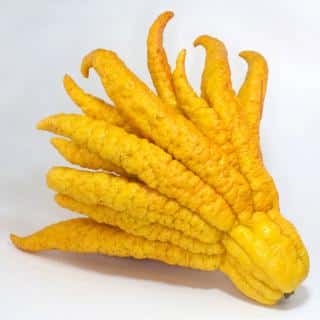

Citron, of which the Buddha’s hand is a variety, is a citrus that produces very original fruits and blooms in a manner much appreciated by perfume makers.
Name – Citrus medica
Family – Rutaceae (Rue family)
Type – fruit tree
Height – 10 to 16 feet (3 to 5 meters)
Exposure – full sun
Soil – well-drained
Foliage – evergreen
Flowering – January to December
Hardiness – at least 40°F (5°C)
Here are our tips: advice on planting, pruning and caring to grow nice citron trees.
The planting of the Buddha’s hand citron tree is very important, because it determines how well the tree will grow, bear flowers and ultimately produce citrons (the ancestor of lemon).
The Buddha’s hand citron tree requires well drained and rich soil for it to develop well.
Before you start, you should know that Buddha’s hand does not resist freezing, and will start suffering when temperatures drop below 40°F (5°C).
Only try to plant the Buddha’s hand citron tree directly in the ground in areas where the winter climate is very mild, or in winter gardens.
This is probably the best way to grow Buddha’s hand citron trees in our temperate latitudes, because our climate is too cool.
Since the size of the Buddha’s hand tree when adult is quite small, about 6 to 10 feet (2 to 3 meters), normally you can avoid any measure of pruning.
However, you can prune a few times to increase growth, help the branches to grow more dense, and get more fruits.
Pruning is best performed in spring, ideally during the months of March, April or May, after the citron harvest.
Pruning should be restricted to the bare minimum:
Using a properly disinfected hand pruner, cut each new shoot back to more or less half its length, taking great care to cut just above a leaf.
The Buddha’s hand citron tree normally doesn’t require any specific watering pattern, except in hotter countries and those countries that suffer from strong droughts in summer.
Never water too much, because the Buddha’s hand citron tree doesn’t cope well with flooded soil.
The Buddha’s hand citron tree planted in a pot doesn’t have the same water needs as a normal ground-grown tree, because the soil in the pot dries up much faster.

When planting was properly performed, and that watering is correctly balanced, this fruit tree should give you much enjoyment and satisfaction.
Just like all other potted plants, adding citrus-specific fertilizer will be needed regularly to compensate the natural loss of nutrients in the soil mix that you’ve provided for it.
Important: The Buddha’s hand citron tree is not an indoor plant and it can’t survive indoors in a heated room all year long, especially not in winter.

Fruit rot, aphids or mealybugs are some of the many diseases and parasites that Buddha’s hand trees can suffer from.
Pick the citrons as soon as they easily break off from the citron tree.
Credits for images shared to Nature & Garden (all edits by Gaspard Lorthiois):
Close hand of Buddha on tree by Pixel2013 under Pixabay license
Open Buddha’s hand by Pixel2013 under Pixabay license
Ripe Hand of Buddha by Kkristie under Pixabay license
Hi i was recently given the fruit from Buddha’s hand and would like to plant it. I was wandering if i can harvest a seed to plant from the fruit and if so where would it be located in the fruit.
At its prime my Buddha’s Hand produced a half-dozen fruit per season. For the last three it has only managed one fruit for the season. Why is it that in the spring after the bloom many fruit just simply shrivel and fall off.
Dear Alfredo,
Sorry to hear the productivity of your buddha’s hand has dropped. Let’s find out what might cause it.
If it’s grown in a pot, the most likely culprit is lack of nutrients. In the first few years it used up whatever nutrients were available, and after a while they ran out. Solution in this case is to either:
* repot the plant in fresh growing medium (half citrus soil mix and half garden soil, a couple handfuls of mature compost, ensure proper drainage with pebbles along the bottom).
* if the pot is too large, simply topdress with fresh soil mix and mature compost.
* add fertilizer. Natural fertilizer such as fermented tea is great, but any store-bought citrus fertilizer will do, too. Avoid too much nitrogen in the fertilizer, favor potassium instead since nitrogen mainly spurs leaf growth.
* generally protect it from wind and drafty areas and ensure a lot of sun. Perhaps the plant has been moved?
If your plant is growing outdoors, check the following:
* has a neighboring tree or plant grown to the point of overshadowing your buddha’s hand? If so, have it trimmed to provide a lot of sun.
* if winter is colder than usual, it might be that a cold spell occurred after the flowering, killing off any weak fruits. Not much to do about this except try to protect the tree against cold winds and eventually setting some thermal mass around it like mineral mulch.
* Perhaps underground limits have been reached, if the plant is growing in rocky soil. Roots have exhausted available resources and nutrients. Solution here is to add a thick layer of plant-based mulch that will slowly decompose and turn into nutrients. If you’ve got compost, use some, too, and for sure try preparing fermented tea fertilizer (see link above).
* Check if wind patterns have changed, too much wind stresses the plant.
Generally speaking it’s normal for citrus plants to drop a large proportion of their fruits. Perhaps in this case it just can’t discern how many to drop and just loses them all. Try the following:
* when you see the tiny fruits starting to form, try pruning off or removing all but one or two on each branch. The goal here is to adjust the load yourself before letting your plant do it. That should ensure you still have six to ten fruits that you’ve selected yourself. Removing the smaller ones early lets the plant realize that it can cope with those remaining.
My oh my, I’ve written quite a lot! Hope this helps!
Dear Gaspard,
Thank you so much for your informative, comprehensive comments; I have a lot to learn. For sure the plan for this week-end is to start applying many of your hints.
Alfredo